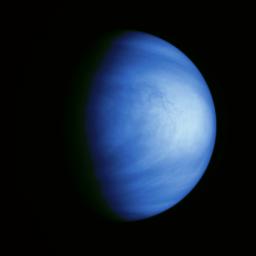
|| Sun || Mercury || Earth || Mars || Jupiter || Saturn || Uranus || Neptune || Pluto ||
|| Home || Aliens|| Quiz || Glossary || UFOs || Universe || Space Craft || Satellites ||

Known for its beauty in the sky, Venus is the second planet from the Sun and similar in size to Earth. However, its immense surface heat and pressure make the planet completely uninhabitable. It has a thick, poisonous atmosphere of carbon dioxide and sulfuric acid. Thick clouds hide a surface covered with lava flows, quake faults and impact craters. In fact, one lava-filled basin is larger than the continental United States and one volcano is taller than Mt. Everest.
These low-lying regions have abundant small volcanoes and long lava flows. Unlike similar plains on the Moon, Mars, and Mercury, the Venusian plains are relatively free of impact craters.
NASA's team has visited Venus. In 1962, Mariner 2 revealed that Venus has cool clouds and an extremely hot surface. Mariner 10 discovered evidence of rotating clouds.
The Soviets have successfully landed several spacecraft in the plains regions. Seven of the landers conducted chemical analyses of rocks, which indicate a composition similar to that of basaltic volcanic rocks found here on Earth. The Venera 9 lander gave us our first glimpse of the Venusian surface when, in 1975, it relayed a panoramic view of the mysterious planet. In 1981, the Venera 13 lander provided the first color images of the surface of Venus.
In the early 1990's, NASA's spacecraft studied the rocky planet, examining the shapes of Venusian mountains, canyons and other surface features with higher resolution than has ever been seen before on a global scale. Magellan data has been used to make maps of the surface properties and the planet's interior. The planet is still geologically active in places, even though radar images of its surface indicate that little has changed in the past half-billion years.
Magellan also examined Venus' massive atmosphere of carbon dioxide and high sulfuric acid clouds.
| Mean Distance from Sun | 108,208,930 km. (6.72 x 107 miles) or 0.723 astronomical units |
| Diameter | 12,103.6 km (7,520.83) miles |
| Volume (Earth = 1) | 0.88 |
| Mass | 4.87 x 1024 kg (0.17 x 1027 ounces) or 0.814 (Earth = 1) |
| Density | 5.24 gm/cm3 |
| Surface gravity | 0.903 (Earth = 1) |
| Rotation period (length of day in Earth days) | 243 Earth days (spins backwards compared to most other planets) |
| Revolution period (length of year in Earth days) | 224.7 Earth days |
| Mean surface temperature | 456.85 C (854.33° F) |
| Natural satellites | None |
|| Our Solar System ||
|| Sun || Mercury || Earth || Mars || Jupiter || Saturn || Uranus || Neptune || Pluto ||
|| Home || Aliens|| Quiz || Glossary || UFOs || Universe || Space Craft || Satellites ||